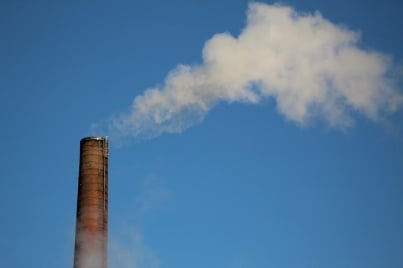Formaldehyde is a colorless gas from fuel combustion, organic matter, and chemicals. Through inhalation or direct skin contact, formaldehyde can cause various health defects. As such, building managers must know the five detectable signs of exposure and implement indoor air quality monitors to help prevent dangerous levels.

When you think of formaldehyde, you may picture embalming fluid or photographic processing materials. But formaldehyde is also a harmful gas that could be in the air you breathe right now or in the office building you'll spend eight hours in tomorrow.
Close to 30% of commercial and residential buildings suffer from "sick building syndrome," where occupants of a building experience various symptoms due to poor indoor air quality. The culprit could be any number of sources, but formaldehyde gas is one potential contributor.
There are several signs and symptoms of formaldehyde exposure to be aware of, and building managers should always keep a close eye on indoor air quality to check for high concentrations of formaldehyde. An indoor air quality monitoring system can help alert you to any issues so you can address them immediately.
The Signs of Formaldehyde in Your Office
Formaldehyde, as an organic compound, is a gas. You can't see it, but it has a pickled, briny odor that should tip you off when you catch a whiff. But the scent isn't always noticeable, especially in heavy industrial settings.
The main sources of formaldehyde are:
- Burning wood, gas, kerosene, tobacco, natural gas
- Household chemicals, paints, and paper coating
- Building materials, such as particleboard, plywood, strand board, and pressed-wood products
- Emissions from living organisms
Even trace levels of the gas can cause noticeable signs of exposure to formaldehyde. Below are the main symptoms that serve as formaldehyde warning signs.
Headaches or Dizziness
If exposed to formaldehyde for long enough, building occupants begin experiencing headaches, lightheadedness, and dizziness. In extreme cases, formaldehyde poisoning has even put people into a coma.
Depression and Mood Changes
Formaldehyde affects humans cognitively, altering certain chemical outputs and brain functions. These formaldehyde signs may include new or enhanced feelings of depression, anxiety, and irritability.
Skin Rashes and Skin Irritations
Direct skin contact or airborne exposure might result in severe rashes. The effects of exposure start with red and hypersensitive skin, followed by itching, cracked skin, and rashes. If left unaddressed for long enough, formaldehyde exposure can cause eczema, dermatitis, or burns.
Shortness of Breath
Formaldehyde has severe effects on the lungs when inhaled. Airborne formaldehyde causes respiratory tract irritation, leading to coughing, wheezing, and shortness of breath. Formaldehyde can also trigger asthma attacks and cause severe illnesses such as chronic obstructive pulmonary disorder.
Eye, Nose, or Throat Irritation
If you're sitting in your office and your eyes begin watering, it's likely not love that's in the air. It could be a sign of formaldehyde exposure. Formaldehyde causes soreness in the eyes, nose, and throat. If you experience a runny or clogged nose, a hoarse throat, or red eyes, check the air for formaldehyde concentrations.
The Risks of Formaldehyde Exposure
The first risk of short-term exposure is to your general comfort. As mentioned above, it can cause irritation, watery eyes, inability to focus, and shortness of breath. But long-term exposure to formaldehyde has also been linked to cancers of the nose, throat, and blood.
Indoor air is more likely to contain dangerous levels of formaldehyde than outdoor air. Formaldehyde is measured in per million parts of air (PPM). Most symptoms set in when formaldehyde exceeds 0.1 PPM. Indoor levels range from .02 PPM to 4 PPM, but outdoor levels are typically well below .01 PPM. However, formaldehyde levels can fluctuate quickly indoors, so monitoring the air as often as possible is critical.
Even small amounts of formaldehyde can lead to serious health effects, so building managers must understand the value of indoor air quality monitoring systems and how they help spot and prevent dangerous levels of pollutants like formaldehyde.
How Exposure to Formaldehyde Can Happen
The gas occurs naturally and artificially from numerous sources, but a few main culprits increase exposure.
Anytime new renovations or construction occurs, you should always test for formaldehyde content in the air. Certain construction products like pressed wood, adhesives, fabric, and insulation carry high levels of formaldehyde. All wood, furniture, paint, and insulation should be tested for formaldehyde before installation, as it can enter the air and affect building occupants.
High formaldehyde content also occurs with inadequate ventilation. All living organisms emit tiny amounts of formaldehyde. Without proper ventilation, formaldehyde gas from organisms and combustion might rise to harmful levels. Always check that your ventilation system's airflow works properly. Likewise, if you use any indoor heaters, ensure they are well-ventilated. Heaters are a large contributor to formaldehyde exposure.
Don't Let Indoor Air Quality Issues Go Unnoticed
Periodic tests aren't the most efficient way to guarantee the air in your office is fit to breathe, and neither is waiting until you see clear signs of formaldehyde exposure. Instead, allow your building to tell you as soon as issues arise. Knowing how indoor air quality sensors keep your tenets or employees safe is the first step to ridding your building of toxic air.
Visit Attune's website to browse some of the best indoor air quality technology on the market. Our sensors constantly analyze indoor air for a variety of critical metrics. All collected data transfers to cloud storage, processes real-time information concerning your indoor air, and displays reports on an easy-to-read dashboard. Here, building managers can monitor air quality in real-time and keep track of occupational exposure to harmful pollutants like formaldehyde.
Don't put it off. Discover how Attune can transform your building today.


